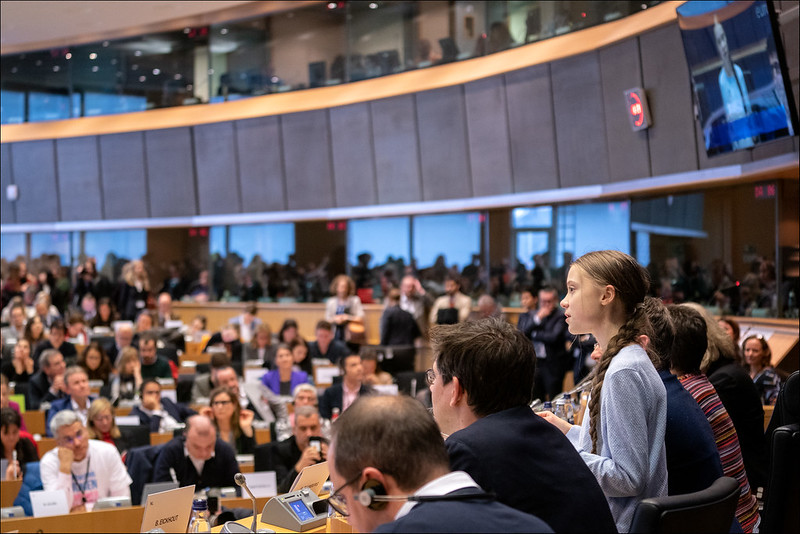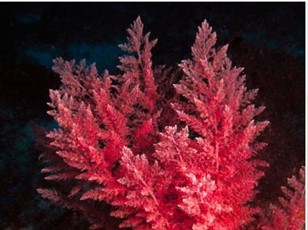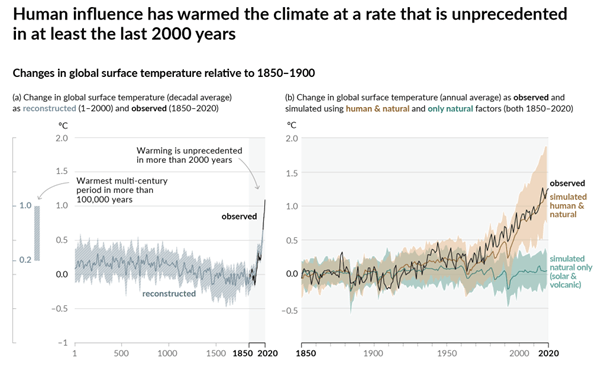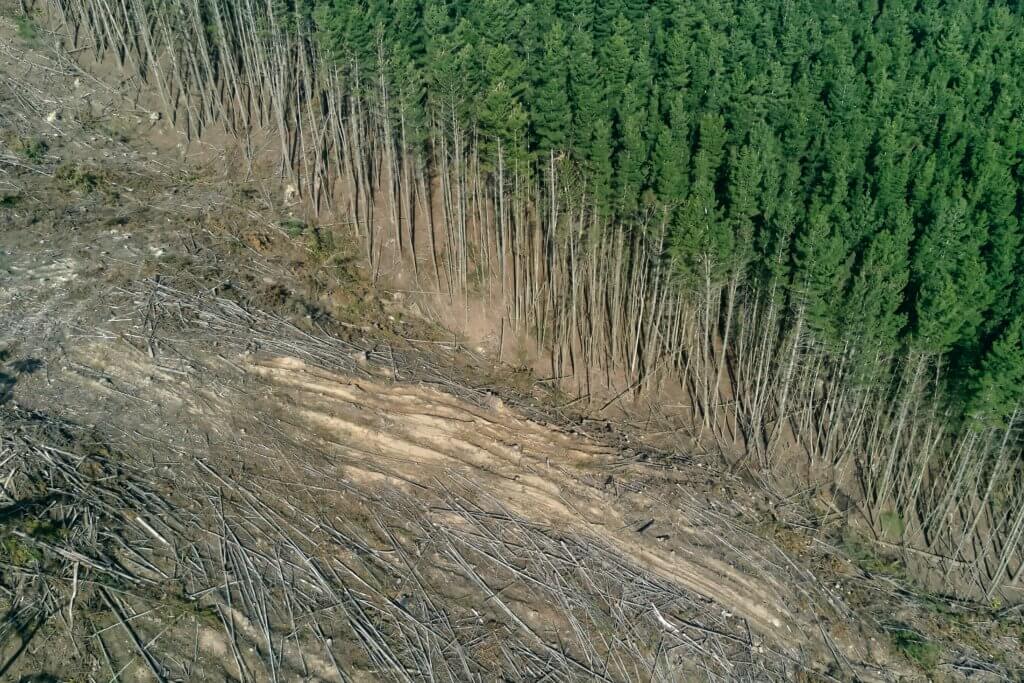Clarence high school Grade 9 Homegroup - Scott

Hello hello Clarence High School Grade 9s!
Thank you for your questions about climate change. You asked some really interesting questions about causes of climate change, taking action, and impacts.
You'll find answers to your questions from our climate experts below - have a read and watch their answers.
You can also have a look at what other classes across Tasmania asked this year, as well as our climate change toolkit.
Our Questions
This is an excellent question, and one of the questions most students want an answer to. You can be someone who takes climate action!
Each of us can act individually (on our own) and collectively (together with others) to act on climate. We know, from scientific evidence, that climate change cannot be stopped and is happening already – but it can be reduced and slowed down. People today and into the future (including you) can make changes and decisions that will greatly reduce climate change and its impacts.
Some of these decisions are happening on a systemic scale - they the really big changes we need to reduce emissions from industries and electricity generation.
For example, world leaders are meeting together at COP26 (which is the UN Climate Change Conference of the Parties) to discuss pathways to do this – in particular, to ensure that global temperature rises do not exceed 1.5 degrees, and how we can adapt to climate change impacts into the future. If we can manage to greatly reduce global greenhouse gas emissions (such as carbon dioxide) we can limit climate change.
You might wonder how young people can influence big changes like this? By using your voices! Young people are involved in many groups and movements such as the School Strikes for Climate that have already made a difference to the way world leaders think about climate action.

At a smaller scale, all of us can do something to make positive changes and have an impact on tackling climate change. Some people can do more and less than others, and that is OK - it’s great actually because lots of small changes can lead to big impact. In everyday life, there’s lot that you might be able to do, for example:
- You can aim to take the bus or walk, or ride your bike to school more.
- You could eat more vegetables, and eat meat less often (maybe even encourage your family and friends to have ‘meat free Mondays’?!). Plant-based foods generally produce fewer greenhouse gas emissions and they also require less energy, land, and water usage.
- You can speak up! Tell your friends and family about climate change and the small changes each of us can do to make a difference - remembering that we all have different abilities to make these changes, big and small.
There are a lot more ideas you can check out on our 'What can I do?' page.
Climate change has many different parts to it and scientists have come up with lots of very promising ways to slow down global warming. Here is one super interesting solution that comes from the oceans.
Have you ever thought about seaweed? It isn’t just smelly stuff that builds up on some beaches, it’s an amazing marine plant that can help us tackle global warming! Seaweeds are plant-like organisms, which mostly live attached to rock in coastal areas. There are many different kinds of seaweeds, from fine delicate red seaweeds (phylum Rhodophyta) like asparagopsis , delicious and nutritious green seaweeds (phylum Chlorophyta) like ulva (which is also known as sea lettuce) to brown seaweeds (phylum Ochrophyta), like kelp. They also range in size from microalgae through the huge bull kelp macroalgaes.
Humans have been eating and using seaweeds for a very long time. Seaweed was a staple food in Japan, Korea and China since at least 600BC. The Icelandic sagas, written in the 10th century, also refer to dulse, a type of red seaweed, as a food. Special seaweed molecules call polysaccharides from red and brown algae are used in all sorts of human foods to help ingredients combine (emulsify) and as a thickener. These are even used in ice cream and toothpaste – next time you clean your teeth check the ingredient list for carrageenan – that’s derived from seaweeds.
But what about as a solution for climate change? To understand seaweed as a solution for climate change, we need to think about cow farts. Seriously, cows release a huge amount of methane into the atmosphere. Methane is one of the main greenhouse gases responsible for global warming and climate change. Cows produce a lot of methane. Just 1 cow can produce up to 120kg of methane in its lifetime, and there are about 1.5 billion cattle world word – that is a lot of cow farts.
Scientists at the CSIRO have worked out that just a small amount of dried asparagopsis (a red seaweed) fed to cattle can reduce their methane output by as much as 80%. Scientists have been working on this for a long time, but it is showing huge promise for stopping one source of methane getting into the atmosphere.
So the science is in and now companies are starting to invest in farming asparagopsis, and making feed additives for cattle.

Stopping, or reducing climate change, known as mitigation, is something that is really important so I’m very glad you’ve asked how to do this.
Reducing climate change will involve lowering the level of greenhouse gases in the atmosphere. This means reducing the emission of heat-trapping greenhouse gases. This is done by reducing the use of fossil fuels and moving to renewable energy sources, like wind, solar and ocean wave energy instead. The effectiveness of these energy sources is improving all the time and around the world (especially in Australia) they are becoming a major source of energy already. Increasing efficiency and finding ways of reducing energy use and waste is also very important. Around the world businesses and governments are making commitments to reduce the use of fossil fuels and to transform manufacturing, food production and transport (e.g. trucks, cars, trains and shipping) to electricity or other fuels (like hydrogen).
Another way to help mitigate climate change is to support processes that actively remove carbon out of the atmosphere. Healthy oceans, forests and soil are great carbon stores. This means restoring and protecting these environments and supporting sustainable practices will help. Growing trees is a great way of helping remove carbon from the atmosphere. This effect is so large that the natural regrowth of Tasmania’s forests means that the state is currently a carbon sink – meaning more carbon is removed from the atmosphere than is emitted. This means as a state Tasmania is doing better than the net zero emissions target governments around the world are talking about.
Rather than just letting the trees do all the heavily lifting though we can help Australia and the world by reducing our individual emissions. On a personal level that means turning lights and appliances off when you’re not using them; putting on a jumper rather than turning the heating up to full; and walking, cycling, or using public transport if we can. Also finding out about what you eat and changing to options that contribute less to climate change can also help. Agriculture is a major producer of greenhouse gases so look for low carbon meals, such as sustainable seafood and local seasonal foods, and try having at least a couple of red meat free days a week.
In addition to reducing energy use we can also consume less (e.g. use clothes for longer rather than chasing the latest fashion look), increase recycling and appropriately dispose of organic waste (e.g. food scraps). Methane is a powerful greenhouse gas, over twenty years it is about 80 times more potent at warming than carbon dioxide. When food and garden waste is buried with general garbage the microbes and chemical processes that break the waste down cannot easily access oxygen and so they produce a lot of methane (known as anaerobic breakdown). However, if you put the organic waste into a compost bin (at home or one provided by the council) the microbes can access oxygen and so they use a process that produces much less methane (known as aerobic breakdown). The nutrient rich compost that results also means more plants can be grown (absorbing carbon) and less energy is needed to make artificial fertiliser. A win-win-win.
The biggest thing you can do to help climate change is to stay informed, to help share useful information and to think about your actions – each little bit really does help. Around the world innovations and action by young people is helping accelerate action to reduce climate change.
For starters, you might like to find out how Tasmania’s tree growth is helping our carbon budget. NASA also has a great page on climate change, which mentions some solutions. The United Nations also has some high-level information on different activities around the world.
You might also like to play with the simple climate model at en-Roads, explore options for reducing climate change
Climate change has many different parts to it and scientists have come up with lots of very promising ways to slow down global warming. Here is one super interesting solution that comes from the oceans.
Have you ever thought about seaweed? It isn’t just smelly stuff that builds up on some beaches, it’s an amazing marine plant that can help us tackle global warming! Seaweeds are plant-like organisms, which mostly live attached to rock in coastal areas. There are many different kinds of seaweeds, from fine delicate red seaweeds (phylum Rhodophyta) like asparagopsis , delicious and nutritious green seaweeds (phylum Chlorophyta) like ulva (which is also known as sea lettuce) to brown seaweeds (phylum Ochrophyta), like kelp. They also range in size from microalgae through the huge bull kelp macroalgaes.
Humans have been eating and using seaweeds for a very long time. Seaweed was a staple food in Japan, Korea and China since at least 600BC. The Icelandic sagas, written in the 10th century, also refer to dulse, a type of red seaweed, as a food. Special seaweed molecules call polysaccharides from red and brown algae are used in all sorts of human foods to help ingredients combine (emulsify) and as a thickener. These are even used in ice cream and toothpaste – next time you clean your teeth check the ingredient list for carrageenan – that’s derived from seaweeds.
But what about as a solution for climate change? To understand seaweed as a solution for climate change, we need to think about cow farts. Seriously, cows release a huge amount of methane into the atmosphere. Methane is one of the main greenhouse gases responsible for global warming and climate change. Cows produce a lot of methane. Just 1 cow can produce up to 120kg of methane in its lifetime, and there are about 1.5 billion cattle world word – that is a lot of cow farts.
Scientists at the CSIRO have worked out that just a small amount of dried asparagopsis (a red seaweed) fed to cattle can reduce their methane output by as much as 80%. Scientists have been working on this for a long time, but it is showing huge promise for stopping one source of methane getting into the atmosphere.
So the science is in and now companies are starting to invest in farming asparagopsis, and making feed additives for cattle.

Let me answer this question across the three levels of government – local, state and national (federal).
While local governments can’t influence national climate policy, they do some important things at the local level, like promoting green building design, installing busways and bikeways and improving public transport to encourage a move away from private vehicle use. They are also responsible for approving new coal mines, although in some states their ability to reject proposed new mines is limited by state-level law.
State governments can provide incentives to industry to change their industrial processes and energy inputs, or make laws actually requiring them to do so. Some state governments offer incentives for people to instal solar panels or energy efficient appliances and could use the car registration system to encourage people to buy electric vehicles.
However, consistent and coherent climate policy really rests with the federal government. The national government has laws requiring a mandatory amount of renewable energy as part of every electricity companies supply. There are also laws relating to energy efficiency. The main plank of the Federal government’s climate policy is the Carbon Solutions Fund. This involves paying individuals and businesses to undertake activities that will reduce emissions. The government initiates a reverse auction in which it invites people to indicate how many emissions reductions they could deliver, at what price. The government then buys those emissions reduction from the party offering to do so at the lowest price. This might achieve small level of emissions reduction, but it costs a lot of money and it will not deliver the kind of transformation that is desperately needed. It provides no incentive for large emitters to reduce their emissions because there are no legal obligations for them to do so and there are no costs associated with continuing with high emitting activities.
The national government could also stop new coal mines by using federal environmental laws. So far it has not done so. In fact, three new coal mines have been approved by the Commonwealth environment minister in the last two months. The Australian government has said that because this coal is intended for export and not domestic consumption, it is not Australia's responsibility to discontinue mining. The responsibility for the emissions coming from burning this coal, according to the government, should rest with the countries that buy the coal. While this may be true in a technical sense based on international carbon accounting rules, it is a missed opportunity in terms of Australia’s leadership on climate action.
Earth’s climate has been changing since it was formed. Sometimes the climate changed quickly, other times more gradually, but there has always been climate change. Before humans this was caused by natural factors such as the strength of the sun, volcanic activity, even meteor impacts. For example, at the time of the dinosaurs, 250 – 65 million years ago, the global climate was hot and humid. Over the past million years, the Earth has gone through cycles of ice ages, where Earth’s surface temperature warmed and cooled by about 5 C every 100,000 years.
But if we ask: “how long has climate change caused by humans been around?” most scientists agree this started around the time human activity began to produce a lot of carbon dioxide. This happened about 200 years ago, at the start of what’s known as the Industrial Era. This is when coal-powered mechanical devices replaced human and animal labour and at the same time the number of humans on earth increased rapidly. Together these changes led to humans emitting more and more carbon dioxide into the atmosphere, and the beginning of human-caused climate change. Some scientists have argued that the earth was headed for another ice age around now, but the carbon dioxide produced by humans starting in the 1800s prevented this.
The screenshot below is from the Global Carbon Atlas. This is an interactive site that shows how human impact on the climate has changed through time- worth checking out. http://www.globalcarbonatlas.org/en/outreach (click on Enter the Past).

Finally, the graphs below can help you work out when climate change caused by humans started. The left-hand graph shows how global temperatures have changed over the last 2020 years. The right-hand side zooms in on the time since 1850 (when the temperatures are based on direct observations using thermometers). It compares the observed climate change (black line) with climate change simulated from a model that includes only natural factors like changes in the sun and changes in volcanic activity (green line), with climate change simulated by a model that includes both human and natural factors (orange line). The black line of the observations follows the orange line quite well, but both of them pull away from the green line starting around 1950. From this we can say that the climate change caused by humans has been around since at least 1950.

Forests are habitats that are dominated by trees, these being plants that are woody and generally above 2 metres in height. The trees are dominant in the forest, but there are also the other smaller plants such as shrubs, herbs and ferns that form the ‘understorey’ of the forest (i.e. ‘under’ the canopy-forming trees). Then there are also the organisms that live in the soil, both above and below. These include countless number of invertebrates that live on the forest floor, both amidst the forest litter, made of debris such as leaves, bark, twigs and flowers/seeds, and in the soil (imagine some of the insects that live your garden soil!). And let us not forget the larger animals that also live in and depend on the forests, such as some of our mammals and birds.
The process of deforestation involves clearing of the forest (hence the ‘de’ in it!). The clearing mainly targets the trees in the case of forestry which involves growing and re-growing of trees so we can harvest the timber form the trees for various uses (e.g. building, paper-making). In other cases, such as happened in large parts of Australia and in other parts of the world such as the Amazon forests, clearing involves completely removing the trees, understorey plants, debris etc. to make way for other land uses such as producing food and fuels. Deforestation also occurs widely to make way for housing developments and associated infrastructure. These distinctions are useful as depending on the reason and nature of deforestation, and what aspects of the forests are cleared, the impacts on the atmosphere (and biodiversity) varies.
For example, if deforestation involves clearing of the trees, other plants and the debris, making way for houses and roads, all of the carbon stored in the landscape (both above and below the ground) is now potentially released back into the atmosphere thereby adding to our historic global greenhouse gas (GHG) emissions. Furthermore, by replacing a functioning forest habitat with a housing sub-division, the ability for those trees and other organisms to continue to take carbon away from the atmosphere and store it in the form of wood and other biomass has been compromised. Within forestry, depending on the nature of forestry practices, again large amounts of carbon can be lost into the atmosphere (where it is causing us harm) and also lost is our ongoing ability to remove harmful pollutants from the atmosphere and store it safely in the form of forest carbon.
The solution therefore is to manage our forestry practices in such a way to provide a net sink (not source) of carbon dioxide (which is a GHG). In other landscapes, the more we can integrate trees and other plants in creative ways, the more we can help remove carbon dioxide from the atmosphere, and also help us cool our cities, bring back birds to our backyards, and gain other benefits of experiencing nature in our daily lives.

This is a great question as it highlights the important role of thinking about our food choices in responding to climate change. But if everyone in the world was vegan, that wouldn’t necessarily be the best way to help slow climate change because we would need a very large land area to grow enough crops. Cutting down trees to clear land for crops is not helpful for climate change because we need trees to help take carbon out of the air.
So instead of everyone in the world being vegan it would be better if everyone in the world reduced how much beef and lamb they ate to maybe once or twice a week or even less and for the rest of the time ate more chicken, fish or vegetarian meals. It is healthier for us to eat less red meat anyway and in Australia we already eat far more red meat than dieticians recommend. That is because we farm a lot of cattle here and our access to high quality and affordable meat is good.
Being vegan can be a much more environmentally sustainable way of eating if you are eating local (or home grown) produce, but it can have health implications for some people, especially children, so it is important to make the decision considering health as well. So the answer is yes, being vegan can really help to reduce emissions but the key part is being aware of what you are eating.

There are also other options to eat more sustainably. Eating food that you grow yourself is great. Do you have chickens at home? As well as eating more locally produced food, including meat. Trying to reduce waste from the food that you eat is also helpful. Eating kangaroo and wallaby is another great option for red meat! Have you tried wallaby? It is great on the BBQ or in a curry. So it is helpful for climate change and our health to reduce the amount of meat we eat, particularly red meat, but meat is still ok in small amounts. Thinking about what we are eating, how it was produced and where it is coming from and making choices that have less emissions is a really great way to help combat climate change.













